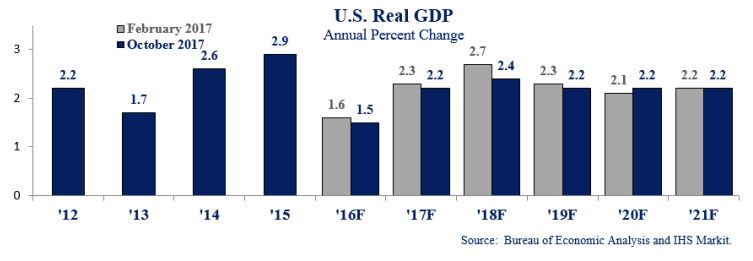This week’s October Revenue and Economic Update gave us somewhat unwelcome news about the state’s economic and budget landscape. The quarterly report from Minnesota Management and Budget (MMB) showed that recent state revenues have come in below projections, and national economic growth is expected to be slightly lower for the next few years than previously projected.
Some of the top takeaways from the Update include:
1. State revenues are coming in below projections. The state’s revenues for the first quarter of FY 2018 (July to September 2017) came in $66 million below projections; that’s 1.4 percent less than projected in the state’s February 2017 Economic Forecast. This is primarily due to lower income taxes received. One spot of good news is the state’s FY 2017 revenues. While preliminary estimates showed revenues coming in 0.5 percent below expectations, the final revenue numbers for FY 2017 are in and were right on target.
2. Slightly lower national economic growth projected over next few years. The national economic forecasters predict 2.2 percent national economic growth for 2017. Despite recent natural disasters, which have delayed economic growth, this is only slightly below the projection from the February forecast. Also, the state’s economic forecasters have changed their assumptions about federal policy action. Previously, the forecasters assumed that federal policymakers would enact tax reductions and increase infrastructure spending, which would boost growth in 2018. They have now removed those assumptions from the model they use to predict how the national economy will fare, bringing down expected growth in 2018 from 2.7 percent to 2.4 percent.

3. Unemployment nationally expected to remain low. Nationally, unemployment in September declined to 4.2 percent. The annual unemployment rate for 2017 is expected to be 4.4 percent, which is expected to improve slightly to 4.3 percent until 2020.
4. Despite uncertainty around federal policy changes, forecasters are fairly confident in their projections. The forecasters assign a 65 percent chance to their baseline forecast. They also give a 20 percent chance for a more pessimistic scenario and assign a 15 percent probability to a more optimistic scenario.
This week’s Update brings us reason for caution. At the federal level, policymakers are proposing serious funding cuts that will make it more difficult for Minnesota to continue to make the investments that strengthen our state and build shared prosperity. President Donald Trump, and the U.S. House and Senate have all put federal budget plans on the table that:
- Significantly cut into annual non-defense appropriations, a substantial portion of which go to state and local governments;
- Include massive cuts to health care funding, again much of which goes to states to fund Medicaid, which helps Minnesotans of all ages access the health care they need; and
- Make deep cuts in assistance to low-income and middle class families through the entitlement portion of the budget, which includes SNAP food assistance, Supplemental Security Income for seniors and people living with disabilities, unemployment insurance, Pell grants and student loans. Again, some of these cuts would push funding responsibility to the states, and others would increase hardship among Minnesota residents and pressure for the state to respond.
This week’s update should give Minnesota’s policymakers pause. The budget that they passed in the 2017 Legislative Session left very little of the projected surpluses, even though there were warning signs that the job of meeting the needs of Minnesotans is likely to get a lot harder.
The next look at the state’s fiscal and economic health will come in early December with the release of the November Budget and Economic Forecast, which will give us a full picture of state revenues, expenditures and economic projections.
-Clark Goldenrod